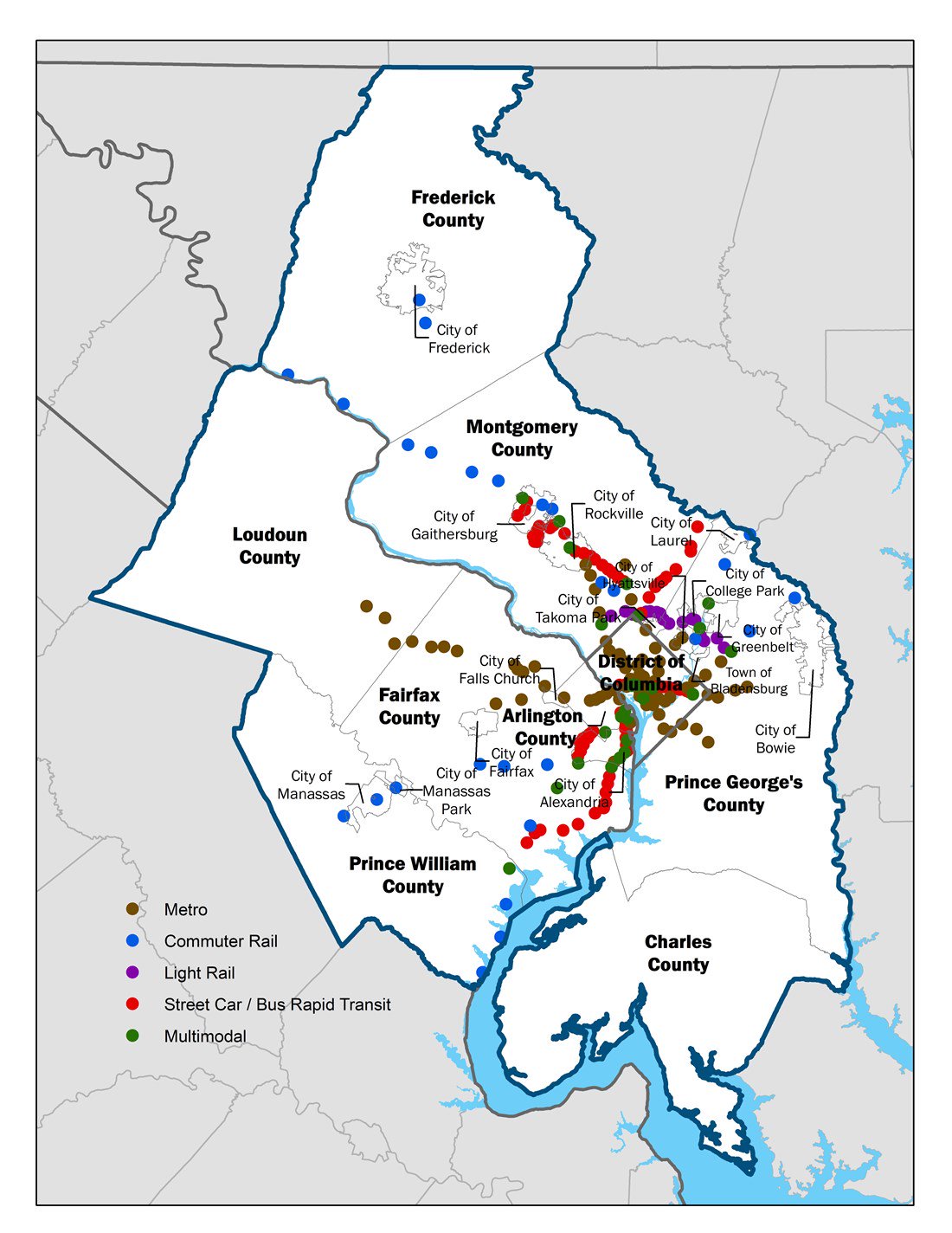At its February meeting, area officials on the COG Board of Directors were updated on efforts to accelerate action on COG’s regional housing targets as well as strategies to support growth around high-capacity transit (HCTs) station areas -- two priorities within the board’s Region United: Metropolitan Washington Planning Framework for 2030.
By leveraging opportunities to include a variety of land uses like office space, retail, community amenities, and housing for all income levels in and around HCTs, the region can create transit-oriented communities (TOCs) that have been proven effective at supporting growth and sustainable, equitable economic development.

High Capacity Transit Station Areas (view the interactive map)
In addition, the region has made a considerable investment in a robust, diverse transit network, and TOCs can ensure that areas served by transit continue to thrive and support the region’s goals and priorities.
“TOCs leverage the region’s significant investment in transit, provide housing at all income levels for families of all sizes, and expand economic development for employers and employees by locating jobs and people closer together. They provide affordable and environmentally friendly travel options,” explained Timothy Canan, COG Planning Data and Research Program Director in a presentation to the board.

The creation of transit-oriented communities is also a key strategy to help achieve COG’s regional housing targets, adopted by the board in 2019.
COG staff shared that more must be done if the region is to meet its target of 75,000 additional housing units by 2030, beyond the 245,000 new units already assumed. Additionally, the 2030 Housing Targets call for 75% of the additional housing units to be located within HCTs and Activity Centers, and 75% of the units affordable to low- and middle-income households.
Although data on permits indicate housing production increased in 2022 to its highest level since 2005, the pace of new units remained below the level needed to reach the region’s annual goal, hampered by market challenges and continuing impacts of the COVID-19 pandemic. Rising home prices and interest rates have presented additional barriers to homeownership and production in the region.

“We already have an affordability crisis, and with interest rates pushing costs even higher, it’s forcing potential homeowners to make some hard choices about where they purchase,” COG Community Planning and Services Director Paul DesJardin told the board.
Housing within HCTs often represents much of the region’s highest housing costs, attractive to residents wanting to live close to amenities such as transit, retail, and jobs. These areas, despite occupying just 5 percent of the region’s land area, can also accommodate significant growth.
In data shared by COG staff, nearly 85 percent of the region’s new multifamily rental units in 2022 were located within HCTs. However, rental costs still present a considerable barrier to many families when accessing housing, limiting the number of people at lower income levels living in and around these transit areas.
Citing recent population declines and migration within and out of the region, board members highlighted how locating diverse and affordable housing with other resources, such as job opportunities across income and education levels, is necessary to support the economic vitality and sustainability of the region and prevent residents from being “priced out” of their existing communities as HCTs expand.
“We’ve got to figure out what are the types of jobs and opportunities that will exist in these communities. How do we position and provide workforce development opportunities and make available access to those larger opportunities that exist across the broader community?” asked COG Board Vice Chair and Fairfax County Supervisor Rodney Lusk.
Noting affordability and other barriers such as zoning regulations and community resistance, board members re-emphasized the need to respond, and communicate, holistically when increasing housing stock around HCTs.
“How we talk about this is just as important as what we’re talking about. As we’re talking about adding homes in transit-oriented areas, we have to have a conversation about how to make sure the infrastructure is in place as well,” said COG Board Member and Loudoun County Chair Phyllis Randall, sharing that residents want to know that schools, green space, and more will be accounted for while increasing housing.
As the region’s housing needs continue to evolve, the area leaders will look to policy solutions and programs (like the COG Housing Affordability Planning Program grants) that strategically locate housing opportunities in and around HCTs to create transit-oriented communities, growing the region’s housing stock while supporting and sustaining equitable, thriving communities.
MORE:
Accelerating Action on Transit-Oriented Communities and Housing Presentations
Multifamily Rental Housing Construction Indicators Report
A New Narrative for Housing: Playbook for the Greater Washington Region